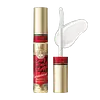What's inside
What's inside
 Key Ingredients
Key Ingredients

 Benefits
Benefits

 Concerns
Concerns

 Ingredients Side-by-side
Ingredients Side-by-side

Water
Skin ConditioningButylene Glycol
HumectantGlycerin
HumectantAlcohol Denat.
AntimicrobialPentylene Glycol
Skin ConditioningAdenosine Phosphate
Skin ConditioningCarbomer
Emulsion StabilisingPhenoxyethanol
PreservativeHydroxypropyl Methylcellulose
Emulsion StabilisingDisodium EDTA
EDTA
Panthenol
Skin ConditioningBiotinoyl Tripeptide-1
Panax Ginseng Root Extract
EmollientRosa Alba Flower Extract
EmollientUlmus Davidiana Root Extract
Skin ConditioningHamamelis Virginiana Leaf Extract
Skin ConditioningAnthemis Nobilis Flower Extract
MaskingHydrolyzed Collagen
EmollientSoluble Proteoglycan
Skin ConditioningSh-Barley Seed Extract
Skin ConditioningSodium Hyaluronate
HumectantCarboxymethyl Chitin
Gel FormingParachlorella Kessleri Exopolysaccharides
HumectantWater, Butylene Glycol, Glycerin, Alcohol Denat., Pentylene Glycol, Adenosine Phosphate, Carbomer, Phenoxyethanol, Hydroxypropyl Methylcellulose, Disodium EDTA, EDTA, Panthenol, Biotinoyl Tripeptide-1, Panax Ginseng Root Extract, Rosa Alba Flower Extract, Ulmus Davidiana Root Extract, Hamamelis Virginiana Leaf Extract, Anthemis Nobilis Flower Extract, Hydrolyzed Collagen, Soluble Proteoglycan, Sh-Barley Seed Extract, Sodium Hyaluronate, Carboxymethyl Chitin, Parachlorella Kessleri Exopolysaccharides
Water
Skin ConditioningButylene Glycol
HumectantDipropylene Glycol
HumectantPEG-400
Emulsion StabilisingSorbitol
HumectantAlcohol Denat.
AntimicrobialGlycerin
HumectantSodium Acrylate/Acryloyldimethyltaurate/Dimethylacrylamide Crosspolymer
Emulsion StabilisingArginine
MaskingXanthan Gum
EmulsifyingZiziphus Jujuba Seed Extract
Skin ConditioningCamellia Seed Oil
Sodium Chloride
MaskingRosa Canina Fruit Extract
AstringentAverrhoa Carambola Leaf Extract
HumectantAorta Extract
Skin ConditioningRubus Idaeus Extract
Skin ProtectingSodium Acetylated Hyaluronate
HumectantMacadamia Ternifolia Seed Oil
EmollientSericin
Skin ConditioningCamellia Euryoides Leaf Extract
EmollientArtemisia Vulgaris Extract
Skin ConditioningHoney Extract
HumectantAspergillus/Camellia Japonica Seed Ferment Extract Filtrate
Skin ConditioningSoluble Collagen
HumectantHydroxypropyl Methylcellulose
Emulsion StabilisingEthylhexylglycerin
Skin ConditioningSodium Citrate
BufferingSimethicone
EmollientCitric Acid
BufferingEDTA
Laurtrimonium Chloride
EmulsifyingHypericum Erectum Flower/Leaf/Stem Extract
Skin ConditioningTocopherol
AntioxidantHydrolyzed Corn Starch
HumectantPotassium Sorbate
PreservativePhenoxyethanol
PreservativeMethylparaben
PreservativeWater, Butylene Glycol, Dipropylene Glycol, PEG-400, Sorbitol, Alcohol Denat., Glycerin, Sodium Acrylate/Acryloyldimethyltaurate/Dimethylacrylamide Crosspolymer, Arginine, Xanthan Gum, Ziziphus Jujuba Seed Extract, Camellia Seed Oil, Sodium Chloride, Rosa Canina Fruit Extract, Averrhoa Carambola Leaf Extract, Aorta Extract, Rubus Idaeus Extract, Sodium Acetylated Hyaluronate, Macadamia Ternifolia Seed Oil, Sericin, Camellia Euryoides Leaf Extract, Artemisia Vulgaris Extract, Honey Extract, Aspergillus/Camellia Japonica Seed Ferment Extract Filtrate, Soluble Collagen, Hydroxypropyl Methylcellulose, Ethylhexylglycerin, Sodium Citrate, Simethicone, Citric Acid, EDTA, Laurtrimonium Chloride, Hypericum Erectum Flower/Leaf/Stem Extract, Tocopherol, Hydrolyzed Corn Starch, Potassium Sorbate, Phenoxyethanol, Methylparaben
Ingredients Explained
These ingredients are found in both products.
Ingredients higher up in an ingredient list are typically present in a larger amount.
Alcohol Denat. is an alcohol with a denaturant property. It is created by mixing ethanol with other additives.
This ingredient gets a bad rep because it is irritating and drying - mostly due to its astringent property. Astringents draw out natural oils in tissue, constricting pores and leaving your skin dried out.
However, alcohol denat. is not all that bad.
Due to its low molecular weight, alcohol denat. tends to evaporate quickly. One study on pig skin found half of applied alcohol evaporated in 10 seconds and less than 3% stayed on skin.
This also helps other ingredients become better absorbed upon application.
Studies are conflicted about whether this ingredient causes skin dehydration. One study from 2005 found adding emollients to propanol-based sanitizer decreased skin dryness and irritation. Another study found irritation only occurs if your skin is already damaged.
Small amounts of alcohol are generally tolerated by oily skin or people who live in humid environments.
The rule of thumb is if this alcohol is near the end of an ingredients list, it will probably not affect your skin much.
Also...
This ingredient has antimicrobial and solvent properties.
The antimicrobial property helps preserve products and increase their shelf life. As a solvent, it helps dissolve other ingredients.
Other types of astringent alcohols include:
Learn more about Alcohol Denat.Butylene Glycol (or BG) is used within cosmetic products for a few different reasons:
Overall, Butylene Glycol is a safe and well-rounded ingredient that works well with other ingredients.
Though this ingredient works well with most skin types, some people with sensitive skin may experience a reaction such as allergic rashes, closed comedones, or itchiness.
Learn more about Butylene GlycolEDTA is the shortened name for ethylenediamine tetraacetic acid. It is a chelating agent and used to stabilize products.
Chelating Agents are used to prevent trace metal ions from binding to other ingredients. This can prevent unwanted reactions or changed efficacy of products.
Glycerin is already naturally found in your skin. It helps moisturize and protect your skin.
A study from 2016 found glycerin to be more effective as a humectant than AHAs and hyaluronic acid.
As a humectant, it helps the skin stay hydrated by pulling moisture to your skin. The low molecular weight of glycerin allows it to pull moisture into the deeper layers of your skin.
Hydrated skin improves your skin barrier; Your skin barrier helps protect against irritants and bacteria.
Glycerin has also been found to have antimicrobial and antiviral properties. Due to these properties, glycerin is often used in wound and burn treatments.
In cosmetics, glycerin is usually derived from plants such as soybean or palm. However, it can also be sourced from animals, such as tallow or animal fat.
This ingredient is organic, colorless, odorless, and non-toxic.
Glycerin is the name for this ingredient in American English. British English uses Glycerol/Glycerine.
Learn more about GlycerinThis ingredient is a semi-synthetic polymer created from cellulose. In case you need a refresher, cellulose is the main component of plant cell walls.
Hydroxypropyl Methylcellulose has many uses:
- emulsifier
- create a gel-like texture
- boost foam
Phenoxyethanol is a preservative that has germicide, antimicrobial, and aromatic properties. Studies show that phenoxyethanol can prevent microbial growth. By itself, it has a scent that is similar to that of a rose.
It's often used in formulations along with Caprylyl Glycol to preserve the shelf life of products.
Water. It's the most common cosmetic ingredient of all. You'll usually see it at the top of ingredient lists, meaning that it makes up the largest part of the product.
So why is it so popular? Water most often acts as a solvent - this means that it helps dissolve other ingredients into the formulation.
You'll also recognize water as that liquid we all need to stay alive. If you see this, drink a glass of water. Stay hydrated!
Learn more about Water